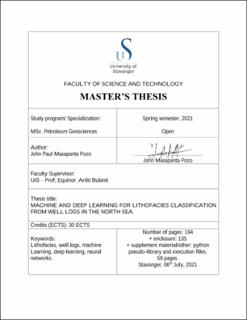| dc.description.abstract | Lithology identification by using well log data is an initial and fundamental step within petroleum geosciences; same that provides essential information about the subsurface and plays a crucial role in reservoir characterization. In addition, well log interpretation is a process that involves a great amount of data, same that is currently handled by experts in order to attain an accurate portrayal of the subsurface. However, as humanity enters the era of big data in companion of the increasing technological and computational development, data science and machine learning are progressively taking over the forefront of the future of the oil and gas industry in order to improve and optimize processes.
In consequence, the objective of current study is to explore and compare the potentiality of different supervised machine learning and deep learning algorithms to classify 12 different lithology facies by using the well log data of 118 wells located in the North Sea, same that are divided into three subsets for training, validation, and testing purposes. Additionally, we explore and discuss a machine-learning-based feature augmentation methodology as an attempt to improve the quality of the original dataset and consequently the final classification results. The analyzed models include standalone algorithms such as Logistic Regression, K-Nearest Neighbor, Supervised Vector Machines, Decision Trees, ensemble gradient boosting tree-based algorithms such as Random Forest, Categorical Gradient Boosting, Light Gradient Booting, and eXtreme Gradient Boosting, and a two-hidden layer Neural Network.
The results showed that by incorporating machine-learning-based feature augmentation every model experienced a performance enhancement, where trees-based gradient boosting algorithms along with random forest, and neural networks appeared to achieve the highest classification performances. Finally, we compare all the models performances and discuss possible reasons why although many algorithms offer high classification performances, they found problems to properly predict mixed-based lithologies, as well as how the interpreters’ subjectivity impact the models performances, and possible future approaches to enhance our best classification accuracy of 82.5% on previously unseen objects.
Keyword: Lithofacies, Well Logs, Machine Learning, Deep Learning, Neural Networks. | |
